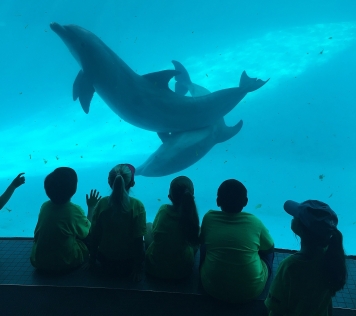Hello all! Hope everyone is safe and well! If not, know that I am thinking of and sending positive, healing thoughts your way! Man, what strange times we find ourselves in, huh? Definitely not how I thought I would be spending my spring, as I am sure all of you are thinking. Right now, I should be finishing up summer camp preparations for all my kiddos! Now, I genuinely don’t know if we’ll even have camp at all. That thought really bums me out. We have a great summer planned – fingers crossed it can still happen! I don’t know about you, but I find the uncertainty very stressful and almost paralyzing. I’ve no doubt that you all are under similar great stress and pressure as well. Positive thoughts going out to everyone!
So, to try and life the mood a bit, I thought I would do a quick round-up of 5 of my favorite dolphin facts as today is National Dolphin Day! Get it, dolphinately a good day to celebrate? Ha! Yeah, ok, I’ll keep my day job (fingers crossed! The economy, am I right?). Alright, before I embarrass myself further, in no particular order, here are 5 things you might not know about these charismatic megafauna!

1. There are about 40 species of extant (living) dolphins! Nearly everyone just thinks of the common bottle nosed dolphin as they can be found all over the world. Yet, dolphins actually have a huge diversity! All dolphins are found in the taxonomical order Odontoceti, or ‘toothed whales.’ Within the Ondontocetes, five families – one oceanic species (Delphinidae) and four river dolphin families (Platanistidae, Iniidae, Lipotidae and Platanistidae) – comprise the 40 species of dolphins.

2. Speaking of dolphin diversity – did you know orcas are dolphins?! Yes, you read that right. There are six oceanic species that include the term ‘whale’ in their common names but are actually genetically in the Delphinidae family. Orcas are one of those six! They are also the largest of all dolphin species. The other five are the melon-headed whale, pygmy killer whale, false killer whale, long-finned pilot whale and the short-finned pilot whale.

3. Their trachea (breathing tube) is not connected to (or anywhere even near) their esophagus (eating tube). This means they can’t choke and do not have a gag reflex! How handy for survival! Instead, their breathing is completely separate, with air exchanging through a special opening on the top of their head – the blowhole. I’m sure you’ve seen the puffs of air (called chuffs) they make when they breach the surface. But don’t worry, they can and do sneeze! If something tickles their blowhole, they will sneeze just like us. Just, maybe a bit more wet then when we sneeze 😉

4. If you were to take an x-ray of their pectoral fins (the fins on the side of their bodies that look like airplane wings), you would find five long bones with joints that look suspiciously like… FINGERS! This is because they ARE modified digit bones. As dolphins are mammals, they share that physical ancient characteristic – just modified into fins (elongated and covered in strong skin tissue) to help them survive in their marine/aquatic habitats. You would find similar in a bat’s wing and other mammals.
-

Wikimedia Commons
5. You probably already know that dolphins employ the use of a special behavior to help them hunt – echolocation. But did you know it involves their jaw bones?? They send out very high frequency pulses of sound, called clicks, that spread rapidly through the water column. When they hit an object or other animal, they bounce off and return to the dolphin. The returning sounds are received in a dolphin’s jaw bones. The vibrations are then relayed to the dolphin’s inner ear and eventually their brain where it is reconstructed as an image. Dolphins don’t use echolocation for just hunting, but to also help them orient themselves in poor visibility habitats.

6. Bonus! What can I say, there are just too many amazing things about dolphins! Keeping on with the auditory theme, I’m sure you know that dolphins are very vocal and communicate with their pod members. But did you know that they have different dialects, languages and some have NAMES! Not human given names – they have their OWN names. Research has discovered that bottle nosed dolphins have unique, signature whistles that are specific to individuals. They use them to identify themselves and pod members when communicating.
Well, I suppose I should stop there – this post is already long enough! It definitely has me thinking a mile a minute about dolphins and their amazing adaptations though. Maybe I’ll do another post going into a few of their adaptations more in depth? What do you think? Want to learn more about dolphins? In any case, I hope these facts brought a smile to your face and distracted you from the rest of the world for a few minutes at the very least!
Be well friends! Till next time!

Leave a comment